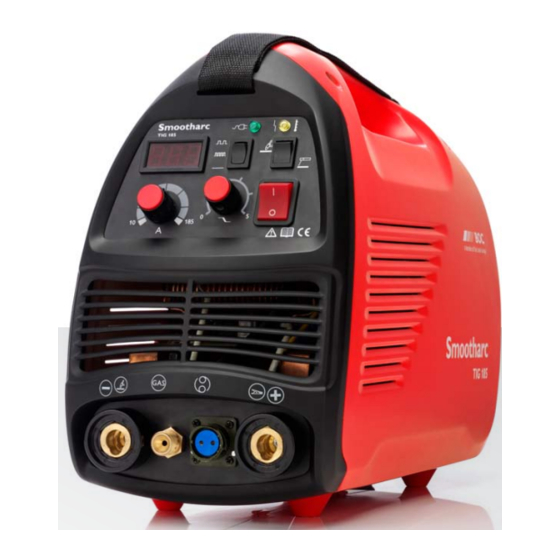BOC Smootharc TIG 185 DC Instrukcja obsługi - Strona 9
Przeglądaj online lub pobierz pdf Instrukcja obsługi dla System spawania BOC Smootharc TIG 185 DC. BOC Smootharc TIG 185 DC 15 stron. Boc smootharc tig 185 dc welder
Również dla BOC Smootharc TIG 185 DC: Instrukcja serwisowa (19 strony)

16
BOC Smootharc TIG 185 Operating Manual
3.0 TIG Welding of Materials
3.1 Application summary
Material
C-Mn steel
Alloyed steel
Copper and Cu alloys
Nickel and Ni alloys
Titanium and Ti alloys
3.2 C-Mn steel
TIG welding may be used for welding carbon steel
but because deposition rates are low, it is usually
only used for welding sheet and thin sections
for high quality applications, small components,
and root passes of multipass butt joints in plate
and pipe.
Standard DC TIG equipment is normally suitable and
DCEN polarity is usually chosen to provide good
workpiece heating.
Only inert or reducing gases should be used for TIG
welding and pure argon is normally recommended
as the shielding gas for steel.
Plate
Tungsten
thickness
Joint
Number
electrode
(mm)
type
of passes
size (mm)
0.8
Fillet
1
1.6
1.0
Fillet
1
1.6
1.5
Fillet
1
1.6
2.0
Fillet
1
2.4
1.0
Butt
1
1.6
1.5
Butt
1
1.6
2.0
Butt
1
2.4
Shielding gas: Argon, Consumable ER70S-6, Position: Downhand, Polarity: DC–
Type of current
Polarity
Direct current (-)
DC negative
Direct current (-)
DC negative
Direct current (-)
DC negative
Direct current (-)
DC negative
Direct current (-)
DC negative
Filler rods are usually selected to match the
chemical composition and the mechanical
properties of the parent plate. The weldability of
the steel may impose restrictions on the choice of
filler rod.
Steels with carbon contents above about 0.3% are
hardenable, and fast cooling will produce a hard
HAZ and this is liable to result in hydrogen cracking.
This form of cracking can be prevented by use of
preheat and suitable welding procedures.
Welding
travel
Consumable
speed
size (mm)
Current (A)
(cm/min)
1.5
70
30
1.5
90
30
2.0
110
30
2.5
130
25
1.5
80
20
2.0
120
20
2.5
140
20
3.3 Alloyed steel
TIG welding may be used for welding alloy steels
but because deposition rates are low, it is usually
only used for welding sheet and thin sections
for high quality applications, small components,
and root passes of multipass butt joints in plate
and pipe.
Standard DC TIG equipment is normally suitable
and DCEN polarity is usually chosen to provide
good workpiece heating. Tungsten electrodes
with additions of thorium oxide, cerium oxide, or
lanthanum oxide are used for welding steel and
they give good arc stability.
Only inert or reducing gases should be used for TIG
welding and pure argon is normally recommended
as the shielding gas for welding alloy steel.
General welding parameters
Plate thickness
(mm)
1.0
1.5
2.0
3.0
5.0
6.0
8.0
12.0
Polarity: DC –
Gasflow
(l/min)
5
5
6
6
6
7
7
BOC Smootharc TIG 185 Operating Manual
Filler rods are usually selected to match the
chemical composition and the mechanical
properties of the parent plate. The weldability of
the steel may impose restrictions on the choice of
filler rod.
Alloy steels with high carbon equivalents are
hardenable, and fast cooling will produce a hard
HAZ and this is liable to result in hydrogen cracking.
This form of cracking can be prevented by use of
preheat and suitable welding procedures.
Tungsten
Gas flow
electrode (mm)
(l/min)
1.0
3 – 4
1.6
3 – 4
1.6
4
1.6 – 2.4
4 – 5
2.4 – 3.2
4 – 6
3.2 – 4.0
5 – 6
4.0
5 – 6
4.8 – 6.4
5 – 7
17
Consumable
Current (A)
size (mm)
30 – 60
1.0
70 – 100
1.5
90 – 110
1.5 – 2.0
120 – 150
2.0 – 3.0
190 – 250
3.0 – 4.0
220 – 340
4.0 – 6.0
300 – 360
4.0 – 6.0
350 – 450
4.0 – 6.0
